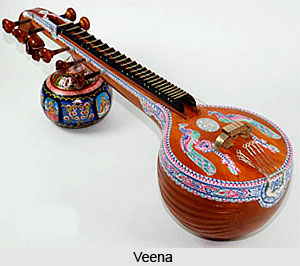 Vedic music was developed and systematic with its fixed tones and scales. Both the pre-Vedic and Vedic music owed much to the undeveloped system of music of the most ancient primitive people. The Vedic literature also furnished various references of Vedic music. Vedic music essentially developed as an accompaniment to religious procedures and rituals. Music was used mainly for two functions: to propitiate deities and to accompany sacrificial offerings. Music formed an important part of the rituals which structured the various sacrifices which formed the essence of the Vedic religion. In fact it has been seen in Vedic literature that instrumental music and dance were divine as they propitiated the deities.
Vedic music was developed and systematic with its fixed tones and scales. Both the pre-Vedic and Vedic music owed much to the undeveloped system of music of the most ancient primitive people. The Vedic literature also furnished various references of Vedic music. Vedic music essentially developed as an accompaniment to religious procedures and rituals. Music was used mainly for two functions: to propitiate deities and to accompany sacrificial offerings. Music formed an important part of the rituals which structured the various sacrifices which formed the essence of the Vedic religion. In fact it has been seen in Vedic literature that instrumental music and dance were divine as they propitiated the deities.
When stanzas of the Rig Veda were set to tones and tunes, they were called the Vedic Sama Gana. In fact, the word Sama itself is a compound expression and includes two entities: the first component `Sa` refers to hymns, i.e. Richa, and the second component, `Ma` refers to the musical notes.
Features of Vedic Music
The Vedas were musically recited. Udatta (sharp or acute), Anudatta (raised, grave) and Swarita (acute, grave) were the three pitches used in Vedic recitative. Sama Vedic music was generally confined to three to five notes. The musical chanting of the Sama Veda employed more notes and finally settled on seven. It is said to be the source of the later secular and classical music. Though all the seven notes were isolated and recognized in course of time in the Vedic period, the chanting always began with the sacred syllable `Om.`
The opera of those days consisted of vocal as well as of a number of instrumental performers. These facts clearly show that in those days, music was in a very advanced stage. Apart from the vocal practice, Vedic music also comprised instrumental music of various types. Both solo as well as choral music were in vogue. Four major forms of music were prevalent in Sama Gayan, taken as a whole. Each kind of music effected different changes in Vedic mantras as was felt to be necessary by the concerned musician. The Veena, Tunav, Dundubhi, Bhoomi-Dundubhi and Talav were the prominent instruments - representing the four major instrumental categories, autophones, membranophones, aerophones and chordophones.
The singing of Sama was accompanied by the Veena. The Veena had to be played in accordance with a procedure that connected body-movements, gestures and correct intonation in singing. Seated in the proper position, the singer had to touch the middle phalanx of the fingers of the right palm with the right thumb according to the pitch of the note intended. A disciple learnt this procedure by imitating his teacher in pitch, intonation as well as in finger movements.
Thus in Vedic music can be seen the beginnings of Indian classical music. Many of the features of the music of this period permeated in various ways and in different proportions in different kinds of Indian music. The music of this time is the earliest example of the deep relationship between religion and music in India.



















